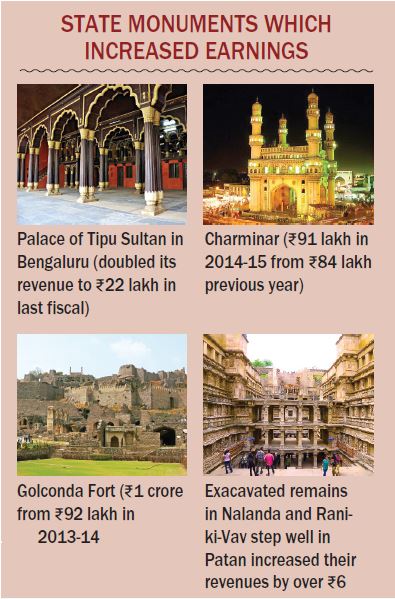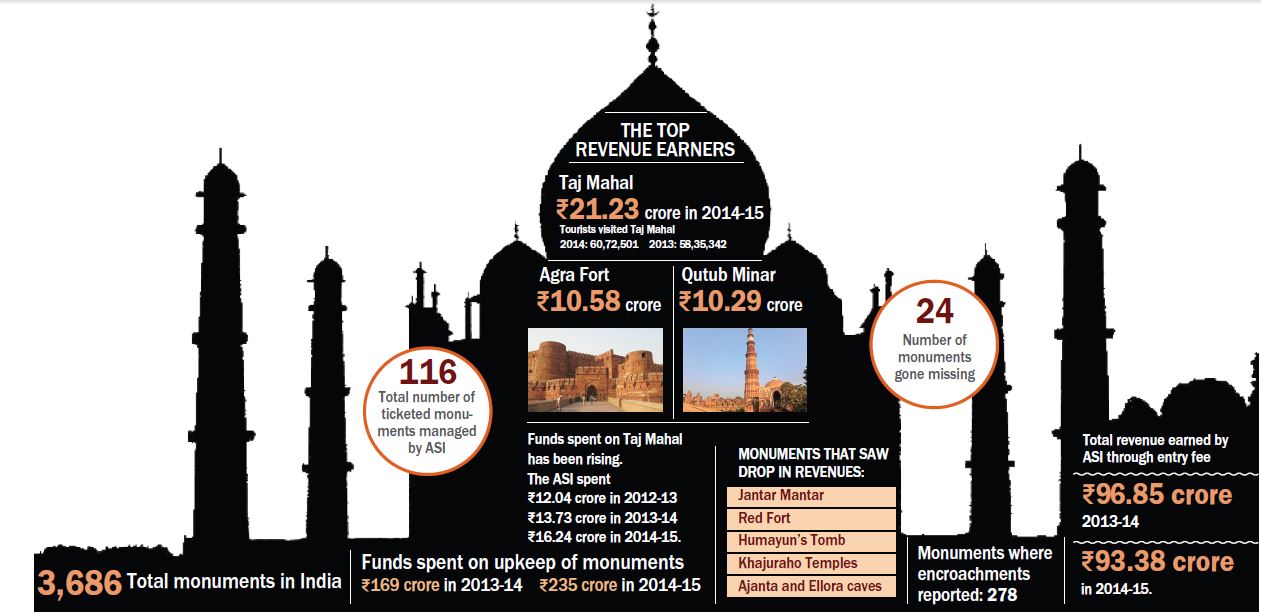New Delhi :
The alluring romance of famous monuments seems to be getting a little jaded with lesser-known ones tucked away in mofussil India garnering increased interest by domestic and foreign tourists. While the iconic Taj Mahal continues to maintain its top position in earnings through entry fees, smaller monuments in states witnessed a spike in revenue. The Palace of Tipu Sultan in Bengaluru almost doubled its revenue with Rs 22 lakhs last fiscal.
Last year, the Taj Mahal lost nearly Rs 60 lakh in revenues earned through entry tickets. In the 2014-15 fiscal, the ‘monument of love’ earned Rs 21.78 crore, while in 2012-13, its revenue was Rs 24.58 crore and Rs 22.40 crore in 2013-14.
Lesser known monuments such as, the Charminar in Hyderabad and Golconda Fort saw a surge in revenues this year; Rs 91 lakh in 2014-15 over Rs 84 lakh in 2013-14, and Rs 1 crore, up from Rs 92 lakh in the previous fiscal respectively.
Taj Mahal apart, some other big attractions showed a downward revenue trend. Revenues from UNESCO monument Red Fort dropped by Rs 10 lakh to earn Rs 5.9 crore, while the newly restored Humayun Tomb earned nearly Rs 70 lakh during 2014-15.
In Delhi, Jantar Mantar made Rs 23 lakh in the last fiscal, a drop of Rs 5 lakh. The Khajuraho Temples lost Rs 20 lakh to earn Rs 2 crore in 2014-15 and Ajanta and Ellora also saw a drop of Rs 2 lakh each.
According to the latest Ministry of Culture figures, many of the 116 ticketed monuments under the jurisdiction of the Archaeological Survey of India (ASI) were helping fill government coffers. In 2013-14, the ASI earned Rs 96.85 crore from monuments, which dropped to Rs 93.38 crore in 2014-15. Ironically, the money does not to go to the cash-starved ASI’s kitty but to the national treasury. Its battle to get the money for conservation of monuments has come to naught.
The excavated remains in Nalanda in Bihar and Rani-ki-Vav (queen’s step well) in Patan, Gujarat, increased their revenues by over Rs 6 lakh each. Rani-ki-Vav was given a Unesco World Heritage Site status this year.
Other monuments that showed increase in revenues, though marginally, include the Rock-cut Hindu Temple at Undavalli and Buddhist Monuments at Guntuplli, both in Andhra Pradesh; Ahom Raja’s Palace at Sibsagar and Ranghar Pavilion at Bisnhudol, both in Assam; ruins of Vikramshila, that was established by King Dharmapala (783 to 820) after a supposed decline in the quality of scholarship at Nalanda, and Sher Shah Suri’s Tomb in Bihar. On the other hand, the famed remains of Pataliputra in Patna showed a downward trend in ticket earnings.
The other significant monuments with increased entry tickets earnings are Sheikh Chilli (Haryana), Kangra Fort (Himachal Pradesh), Badami Caves and Gol Gumbaz in Karnataka, and Mandu monuments and Sanchi (Madhya Pradesh).
In Maharashtra, Ajanta and Ellora’s losses in revenue were gains for Aurangabad, Elephanta , Karla and Buddhist Kanheri Caves. In Delhi, Purana Qila, (which dates back to the days of the Mahabharata), Safdarjung Tomb and Tughlaqabad earned more this year while earnings from Red Fort and Humayun’s Tomb dipped. In Tamil Nadu, except for the Rock Cut Jain Temple in Sittannavassal, ticketed monuments like forts in Gingee and Dindigul had lesser earnings in 2014-15.
Interestingly, the Taj Mahal, Agra Fort and Qutub Minar collectively contributed over 45 per cent of the revenues through entry fee for ASI-run monuments The 17-century marble tomb with its intricate inlay work built by Mughal emperor Shah Jahan has been earning over Rs 20 crore every year through entry fees. Its revenue collections saw a drop in the last three years even though footfalls have been increasing. In 2012-13, Taj Mahal earned Rs 24.58 crore, Rs 22.40 crore in 2013-14 and Rs 21.78 crore in 2014-15.
“There has been no decrease in the number of total tourist footfalls in the past two years. In 2014, 60,72,501 domestic and foreign tourists visited Taj Mahal, against 58,35,342 in 2013,” culture minister Mahesh Sharma said.
Ironically, it isn’t just the Taj Mahal whose revenues have dropped. Revenue from the Khajuraho temples fell by Rs 20 lakh to Rs 2 crore in 2014-15, and Ajanta and Ellora also saw a drop of Rs 2 lakh each.
Indians and those from SAARC and BIMSTEC countries pay between Rs 5-10 while foreigners have to pony up between Rs 100 to Rs 500, depending on the monument.
On the other hand, funds spent on the upkeep of the Taj has been rising. The ASI spent Rs 12.04 crore in 2012-13, Rs 13.73 crore next year and Rs 16.24 crore in 2014-15. Agra Fort, built by the Mughals in neighbourhood of the Taj earned Rs 10.58 crore in the last fiscal, while Qutub Minar grossed Rs 10.29 crore through ticket sales, a marginal increase over the previous year.
source: http://www.newindianexpress.com / The New Indian Express / The Sunday Standard / by Pratul Sharma / August 02nd, 2015











